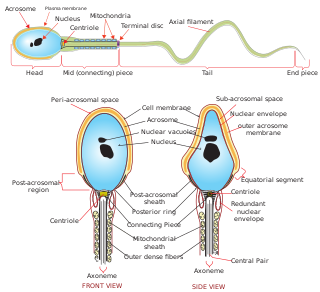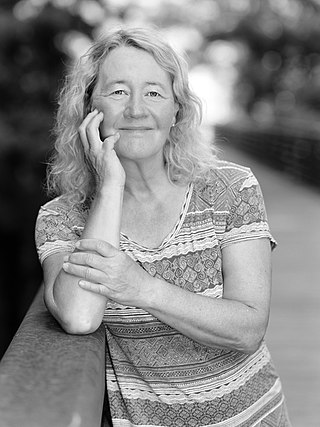Related Research Articles

Estrogen or oestrogen is a category of sex hormone responsible for the development and regulation of the female reproductive system and secondary sex characteristics. There are three major endogenous estrogens that have estrogenic hormonal activity: estrone (E1), estradiol (E2), and estriol (E3). Estradiol, an estrane, is the most potent and prevalent. Another estrogen called estetrol (E4) is produced only during pregnancy.

Progesterone (P4) is an endogenous steroid and progestogen sex hormone involved in the menstrual cycle, pregnancy, and embryogenesis of humans and other species. It belongs to a group of steroid hormones called the progestogens and is the major progestogen in the body. Progesterone has a variety of important functions in the body. It is also a crucial metabolic intermediate in the production of other endogenous steroids, including the sex hormones and the corticosteroids, and plays an important role in brain function as a neurosteroid.

Estradiol (E2), also spelled oestradiol, is an estrogen steroid hormone and the major female sex hormone. It is involved in the regulation of the estrous and menstrual female reproductive cycles. Estradiol is responsible for the development of female secondary sexual characteristics such as the breasts, widening of the hips and a female-associated pattern of fat distribution. It is also important in the development and maintenance of female reproductive tissues such as the mammary glands, uterus and vagina during puberty, adulthood and pregnancy. It also has important effects in many other tissues including bone, fat, skin, liver, and the brain.

Progestogens, also sometimes written progestagens or gestagens, are a class of natural or synthetic steroid hormones that bind to and activate the progesterone receptors (PR). Progesterone is the major and most important progestogen in the body. The progestogens are named for their function in maintaining pregnancy, although they are also present at other phases of the estrous and menstrual cycles.

The acrosome is an organelle that develops over the anterior (front) half of the head in the spermatozoa of many animals including humans. It is a cap-like structure derived from the Golgi apparatus. In placental mammals the acrosome contains degradative enzymes. These enzymes break down the outer membrane of the ovum, called the zona pellucida, allowing the haploid nucleus in the sperm cell to join with the haploid nucleus in the ovum.
Steroid hormone receptors are found in the nucleus, cytosol, and also on the plasma membrane of target cells. They are generally intracellular receptors and initiate signal transduction for steroid hormones which lead to changes in gene expression over a time period of hours to days. The best studied steroid hormone receptors are members of the nuclear receptor subfamily 3 (NR3) that include receptors for estrogen and 3-ketosteroids. In addition to nuclear receptors, several G protein-coupled receptors and ion channels act as cell surface receptors for certain steroid hormones.
Hyperactivation is a type of sperm motility. Hyperactivated sperm motility is characterised by a high amplitude, asymmetrical beating pattern of the sperm tail (flagellum). This type of motility may aid in sperm penetration of the zona pellucida, which encloses the ovum.

The progesterone receptor (PR), also known as NR3C3 or nuclear receptor subfamily 3, group C, member 3, is a protein found inside cells. It is activated by the steroid hormone progesterone.

11-Deoxycorticosterone (DOC), or simply deoxycorticosterone, also known as 21-hydroxyprogesterone, as well as desoxycortone (INN), deoxycortone, and cortexone, is a steroid hormone produced by the adrenal gland that possesses mineralocorticoid activity and acts as a precursor to aldosterone. It is an active (Na+-retaining) mineralocorticoid. As its names indicate, 11-deoxycorticosterone can be understood as the 21-hydroxy-variant of progesterone or as the 11-deoxy-variant of corticosterone.
The cation channels of sperm also known as Catsper channels or CatSper, are ion channels that are related to the two-pore channels and distantly related to TRP channels. The four members of this family form voltage-gated Ca2+ channels that seem to be specific to sperm. As sperm encounter the more alkaline environment of the female reproductive tract, CatSper channels become activated by the altered ion concentration. These channels are required for proper fertilization. The study of these channels has been slow because they do not traffic to the cell membrane in many heterologous systems.

2-Arachidonoylglycerol (2-AG) is an endocannabinoid, an endogenous agonist of the CB1 receptor and the primary endogenous ligand for the CB2 receptor. It is an ester formed from the omega-6 fatty acid arachidonic acid and glycerol. It is present at relatively high levels in the central nervous system, with cannabinoid neuromodulatory effects. It has been found in maternal bovine and human milk. The chemical was first described in 1994-1995, although it had been discovered some time before that. The activities of phospholipase C (PLC) and diacylglycerol lipase (DAGL) mediate its formation. 2-AG is synthesized from arachidonic acid-containing diacylglycerol (DAG).

Carolyn Widney Greider is an American molecular biologist and Nobel laureate. She joined the University of California, Santa Cruz as a Distinguished Professor in the department of molecular, cell, and developmental biology in October 2020.
The Centre for Human Reproductive Science (ChRS) was established in December 2006 to further develop research and innovation in fertility diagnosis and treatment, working in partnership as the academic and research wing of the Birmingham Women's Fertility Centre at Birmingham Women’s Hospital and the University of Birmingham Medical School. A particular emphasis in the biomedical research strategy is placing research and discovery in the true physiological context.

Abhydrolase domain-containing protein 2 is a serine hydrolase enzyme that is strongly expressed in human spermatozoa. It is a key controller of sperm hyperactivation, which is a necessary step in allowing sperm to fertilize an egg. It is encoded by the ABHD2 gene.

Karl Heinrich Slotta, was a biochemist. His discovery of progesterone and its relationship to ovulation led to the development of birth control pills.

Progesterone (P4) is a medication and naturally occurring steroid hormone. It is a progestogen and is used in combination with estrogens mainly in hormone therapy for menopausal symptoms and low sex hormone levels in women. It is also used in women to support pregnancy and fertility and to treat gynecological disorders. Progesterone can be taken by mouth, in through the vagina, and by injection into muscle or fat, among other routes. A progesterone vaginal ring and progesterone intrauterine device used for birth control also exist in some areas of the world.
Marion Sewer (1972-2016) was a pharmacologist and professor at the University of California, San Diego's Skaggs School of Pharmacy and Pharmaceutical Sciences known for her research on steroid hormone biogenesis and her commitment to increasing diversity in science. Much of her research centered around cytochrome P450, a family of enzymes involved in the conversion of cholesterol into steroid hormones. She died unexpectedly at the age of 43 from a pulmonary embolism on January 28, 2016 while traveling through the Detroit airport.
Ann M. Nardulli was an American endocrinologist known for her research into the role of estrogen in breast cancer.

Gopalan Shyamala was a biomedical scientist at the Lawrence Berkeley National Laboratory, whose work in isolating and characterizing the progesterone receptor gene stimulated advances in breast biology and oncology. She was the mother of Vice President of the United States Kamala Harris and Maya Harris, a lawyer and political commentator.
Sarah Martins Da SilvaMRCOG is a British gynaecologist and researcher specialising in male infertility. Da Silva is a senior lecturer in reproductive medicine at the University of Dundee. She also works as an honorary consultant gynaecologist at the Ninewells Hospital in Dundee, specialising in fertility problems and assisted conception. She was named one of the BBC's "100 Women of 2019" for her contribution to fertility science.
References
- ↑ "Pew Funds Six Teams to Pursue Cutting-Edge Biomedical Research". www.prnewswire.com. Retrieved 2020-10-11.
{{cite web}}: CS1 maint: url-status (link) - ↑ "Polina V. Lishko - MacArthur Foundation". www.macfound.org. Retrieved 2020-10-11.
- ↑ "Stanford and Berkeley researchers among MacArthur 'genius grant' recipients". The Mercury News. 2020-10-06. Retrieved 2020-10-11.
- ↑ "Polina V. Lishko, Ph.D." Pew Trusts. Retrieved 2020-10-11.
{{cite web}}: CS1 maint: url-status (link) - ↑ "Faculty". BUCK. Retrieved 2020-10-20.
- 1 2 Sanders, Robert (2020-10-06). "Contraceptive researcher Polina Lishko receives MacArthur "genius" award". Berkeley News. Retrieved 2020-10-20.
- ↑ "Polina Lishko – 10th World Conference of Science Journalists, San Francisco 2017". wcsj2017.org. Retrieved 2020-10-11.
- ↑ "Rachelle Gaudet". projects.iq.harvard.edu. Retrieved 2020-10-20.
- ↑ Kirichok, Yuriy; Lishko, Polina V. (August 2011). "Rediscovering sperm ion channels with the patch-clamp technique". Molecular Human Reproduction. 17 (8): 478–499. doi:10.1093/molehr/gar044. ISSN 1360-9947. PMC 3136206 . PMID 21642646.
- ↑ "Research". Lishko Lab at Berkeley. Retrieved 2020-10-19.
- ↑ Miller, Melissa R.; Mannowetz, Nadja; Iavarone, Anthony T.; Safavi, Rojin; Gracheva, Elena O.; Smith, James F.; Hill, Rose Z.; Bautista, Diana M.; Kirichok, Yuriy; Lishko, Polina V. (2016-04-29). "Unconventional endocannabinoid signaling governs sperm activation via the sex hormone progesterone". Science. 352 (6285): 555–559. Bibcode:2016Sci...352..555M. doi: 10.1126/science.aad6887 . ISSN 0036-8075. PMC 5373689 . PMID 26989199.
- ↑ Eisner, David A. (2022-02-18). "2022". Journal of General Physiology. 154 (3). doi:10.1085/jgp.202213123. ISSN 0022-1295. PMC 8906280 . PMID 35179559.